-
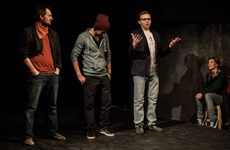
Opening Event - Double Bind theatre performance
A double bind is an emotionally distressing dilemma in communication in which an individual (or group) receives two or more conflicting messages, and one message negates the other. This creates a situation in which a successful response to one message results in a failed response to the other (and vice versa), so that the person will automatically be wrong regardless of response. The double bind occurs when the person cannot confront the inherent dilemma, and therefore can neither resolve it nor opt out of the situation.
Read more ...
-

Neorealism and newrealism
The road map this retrospective tries to describe and create is the journey of the seeds planted by the neorealist experiment, introducing works that question the concept of documentary as privileged film genre considering its relationship with reality, and in order to do so focusing on the representation of such reality. This is a partial selection – in both time and space – whose goal is to suggest other relationships between other filmographies.Technical conditions for mobility and small teams allowed cinema to be critic, witness and researcher, looking at those who had been so far invisible: a “portable cinema” creating poetry from the popular imaginary and the ability people have to self-reflection: La Terra trema, Umberto D.Subarnarekha is part of a trilogy on refugees by Ritwik Ghatak, and one of the fundamental films of India's Parallel Cinema. Gatak himself was a refugee during East Bengali’s great crisis in 47.In Adela Adolfo Alix Jr. films Anita Linda (a former radio diva) in the slums of Manila, building an analysis of Philippine’s violent class system, in a game of self-fiction by those who are filmed.In 1961 Mackenzie directed The Exiles, with the Native American community in the outskirts of LA: those who do not belong anywhere, emerging in long takes that build up a “realism of duration” (R. Koehler).The Death of Mr. Lazarescu by Cristi Puiu is key to understand Romanian New Wage Cinema. The author and the camera’s point of view are alternative to the totalitarian state imaginary, in a minimalistic principle (both narrative and pictorial) reflecting a possible realism in cinema.From Portugal, Os Mutantes, by Teresa Villaverde: in a country disappointed by an unfulfilled revolution and numbed by the European dream, outcast institutionalised teenagers wander around in a parallel reality to the Lisbon of the 90’s. Commited to reality, cinema refused aesthetic and political constraints of traditional documentary and engaged in a pact with the people and with cinema itself. Cíntia Gil, Davide Oberto
Read more ...
-

Politics of communication: Drawing
They say that “a picture is worth a thousand words”. Reality has repeatedly proved us that a drawing in the media is the equivalent of an article and, sometimes, even of an entire newspaper.The terrorist attack that took place in January this year at the premises of the Charlie Hebdo Magazine in Paris is still fresh in the collective memory, being launched as a response to the publication of a caricature of Muhammad, which Islamic fundamentalists perceived as defamatory. Almost the entire editorial staff was killed in the assault and it gave birth to a massive solidarity movement on social media. Millions of people from Europe and from all around the world declared at that time: “Je suis Charlie!”Recently this year, the Charlie Hebdo Magazine also published two caricatures related to the death of the three-year old Syrian boy who drowned in the Mediterranean Sea while his parents were trying to get to Europe. This time, the worldwide public pressed tough charges on the Magazine and accused the French of having crossed the line.But what is the right limit and when is it about political drawing?The documentary Cartoonists introduces us to twelve cartoonists from all over the world and their day-to-day work, which entails a constant clash with the boundary of the affectability of the society in which they live and draw, a boundary which is often went over in their drawings. How can a few lines synthesize such complicated and serious matters? Who are those who risk their lives for a drawing? What is the role of caricatures in political communication?Visual artist Dan Perjovschi will try to outline the possible answers to these questions, reflecting on the experience of cartoonists around the world, as well as on his own experience in the field.The conference will be held on 6th October at Astra Film Cinema hall after the screening of 'Cartoonists - Foot Soldiers of Democracy'. *********** Dan Perjovschi is a Romanian drawer, illustrator, writer, journalist and performance artist. His artworks represent a combination of drawings, cartoons, raw art and graffiti, and they are temporarily exhibited on the walls of museums and contemporary art spaces all over the world. Perjovschi approaches current social issues in his artworks and he has played an important part in the development of the civil society in Romania as an illustrator and writer for Revista 22 cultural magazine in Bucharest. His works were exhibited in the USA, Portugal, Spain, Germany, Hungary, Sweden, Switzerland, the UK, Mexico, Brazil, South Korea, China, etc.
Read more ...
-

Life under Communism
The half-century since the installation of the Ceausescu dictatorship and the twenty five years since the Revolution offer a temporal standpoint fit to contemplate from a comfortable distance what has been called in recent Romanian history, “The Golden Age”. How was life during the communist regime in reality? The answers may vary somewhere along the lines of vilification, idealisation and indifference.This Astra Film programme tries to uncover the extent to which the visual documents preserved as documentaries, footage and photos can help us reconstruct how people lived at that time and the register needed to view and interpret these materials so that they may convey an image that is closest to the reality of those years. Under the format of an Open session, "Life under communism" presents two Romanian documentary filmmakers who were active during the Ceausescu regime: Slavomir Popovici and Ioan Agapi.What were the implications of being a documentary director employed by the system? What was the annual production, how were the themes chosen, to what extent was the content negotiable and how did censorship operate? What was the purpose of making films? How and where were they distributed? Although they worked in a time when communist propaganda controlled everything related to film production, Slavomir Popovici and Ioan Agapi went on atypical routes – that is why their creative activity speaks volumes about those years, provided their films are correctly interpreted.There will be a debate about the end of communism after the screening event of “1989”, a documentary that goes beyond the closed doors where political games were secretly carried out, which would lead to the collapse of communism. The film is an interweaving of reconstructions, archival footage and testimonials, and it combines great historical events with the personal tragedies of those who were at that time caught in the crossfire while trying to escape the Eastern Bloc.The screening will be followed by a discussion with film director Erzsebet Racz and Judith Urban, Consul of Germany in Sibiu, eye-witness of the events as junior assistant of the Embassy of West Germany in Budapest. Visual Memory of Communist Romania in Personal Film Archives: Ioan Matei AgapiIoan Agapi is a singular character among Romanian documentary filmmakers of the communist era. In a time when most artists and filmmakers were compelled to work under the direct supervision of official institutions, Agapi somehow managed to gain the status of an independent visual artist and stick to it. This gave him the privilege to capture on film political and social events from a more personal and intimate perspective than any other director. The communist propaganda agents thought they were using him, but the fact of the matter was that he was using them, i.e. he was taking advantage of their filmmaking facilities to develop his own personality as a documentary filmmaker.Agapi was born in 1936 in Huși. He studied documentary filmmaking in Bucharest in the 1960s. After graduation, he got a job as a teacher at the Traditional School of Arts in Iași and at the Municipal Arts Centre in Huși, where his tasks included making propaganda films. Between 1968 and 1993 he filmed 16 mm documentaries and feature reportages. His work includes propaganda films made at congresses of the Romanian Communist Party or featuring high-ranking communist party officials at various events, but also documentaries about cultural events, traditional customs, demolition of houses and even mundane street moments.After the collapse o communism, Agapi tried to trace his earlier works at the institutions that had commissioned them, only to find out that most of them were lost or simply thrown away because they were no longer of use. Luckily, besides being a filmmaker and a photographer, he is also a passionate collector. His personal archive includes 21,000 meters of film footage, the equivalent of 32 hours of video footage (recently digitalized) and a few finalized short films, a selection of which is presented by Nora și Ioan Agapi. Slavomir Popovici (1930-1983) is one of the most valuable Romanian documentary filmmakers (of Serbian origins). While working at the Documentary Film Studio ”Alexandru Sahia”, he innovated in each of his films, whether they were commissioned or made on personal initiative. This put him in a constant struggle with censorship, not only regarding films inspired by contemporary reality, but also after having decided to exclusively make old art and ethnographical films.The screening of a selection of the director’s films (A Chronicle, Dark Sun, Factory) will be accompanied by an analysis of the way documentaries were made at the Sahia Studio during the communist regime (1960-1989). By talking to several elderly employees of the studio, directors, writers, operators, going beyond the way the system worked in terms of propaganda, production, censorship and distribution, we discovered that there was, however, a friendly atmosphere. Good films, or rather decent films could be “sneaked in”, as long as they complied with the mostly absurd conditions imposed: not showing poverty, filth, churches, death, capitalism…After all, what was the status of a documentary filmmaker at that time? He was just another civil servant, but in a privileged position that allowed for some degree of freedom, bohemian behaviour and an above-average income. This privilege existed as long as the filmmaker understood the mechanisms of self-censorship, the limits and sacrifices of creation in a totalitarian regime, however mild.
Read more ...
-

Under Height Limits
1% of the world population is born with a growth deficiency as a result of a genetic condition. They are called 'dwarves' and they live in our world, meaning a universe standardized based on the height limits we consider to be 'normal'. Since this is how it is, they are forced to adapt. The plastic chair must always be around, in their own kitchen, as well as at the supermarket; cars and bicycles must be adjusted, so they can reach the pedals. Some are saddened by their condition, others retreat in the company of animals because in the human society they are almost always exposed to curious glances or unpleasant remarks. They long for a 'normal' life. They throw parties and prefer the company of their own kind, this is what we learn from the documentary For Ever Little.Dwarves have attracted human sympathy since the dawn of time. In classic fairytales, dwarves are the most likeable characters among those who are 'different' from birth. However, in real life, the exploitation of dwarves in theatre and circus shows is a long and very little known story, one that continues to this day. The film Little people big dreams presents a huge amusement park in present-day China, created after the representative Disneyland; the thing that distinguishes the two is that this is Dwarvesland, not Walt Disney territory, where all the entertainers are dwarves. The documentary follows their life backstage and presents touching portraits. Most of them are confronted with the same dilemma: should they quit a job exploiting them and exposing them on a daily basis to the hurtful curiosity of tourists or should they stay for the sake of the team and the pleasure of being part of a community?The third dwarf story in this programme belongs to the realm of fantasy. It is the story of Ovitz family from Maramures, evoked in the film Seven Dwarfs of Auschwitz. Before World War II, the seven dwarf brothers, talented singers and performers, were on tours in Romania, Hungary and Czechoslovakia with their company, Liliput. During the Nazi occupation, it seemed that their fate was sealed. They were dwarves and, above all, they were also Jews. They were deported to Auschwitz, where they escaped the gas chamber only because doctor Mengele took interest in them, adding them to his collection of human guinea pigs and subjected them to all kinds of experiments. Their life in the camp and after their discharge, up to the point when they settled in Israel at the end of the 1940s, is truly an odyssey. The story of the Ovitz brothers is narrated by the actor Warwick Davies, himself a dwarf, which did not stand in the way of his enviable career on the big screen. He believes that by accepting the shortcomings and the talents with which you are born and by striving to cultivate the latter, things become clear in your life.“If I could live life again, I’d still be short” - Warwick Davies said in an interview.
Read more ...
-
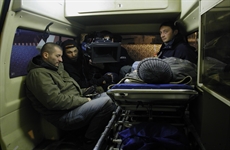
Behind the scenes
The Death of Mr. Lazarescu, A making of The most awarded Romanian film, The Death of Mr. Lazarescu (2005), directed by Cristi Puiu, was shot in 39 nights, between November and December 2004. Andrea Păduraru was there operating the camera at each shooting and she gathered 200 hours of footage for the making-of.The event entitled Behind the scenes will open a debate with questions regarding the process of creating a reality which was to take the form of a narrative film.How useful was the script as a tool employed to introduce the team to the world of the film which was about to be born?What are the directorial secrets by means of which the narrative film becomes a reality in which the captivated spectator enters, resonating with every detail and living the story from the point of view of an invisible witness?To what extent did the team members present on the set (the cinematographer, camera operators, actors, assistant director) know or intuit the takes that were to be used in the final cut? How much can a making-of render the reality of the filming period as a whole, being built upon the thread of emotional experience and team interactions?
Read more ...
-

Aristoteles Workshop 10.
Aristoteles Workshop is a documentary film program dedicated to youngprofessionals in Central and Eastern Europe, initiated in partnership with ARTEFrance, which takes its participants from brainstorming ideas, to shooting, editingand finally screening a short documentary film, under the guidance of renowneddocumentary filmmakers and experts.Since its first edition in 2006, over 130 participants produced 36 films,more than half of which were selected and awarded at various film festivalsaround the world.This year is AW’s 10 years anniversary, which will be hosted by ASTRAFilm Festival. On the 9th and 10th of October, in Sibiu, AW organizers,accompanied by special guests and former participants will gather for screeningsof a selection of best AW films, open discussions with the filmmakers and talkson documentaries and the success recipe of a documentary film workshop.
Read more ...
-
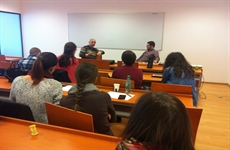
Doc & Academic Research Open Session
În Romania sunt ocazii puține pentru tineri să învețe să facă film documentar. În această sesiune deschisă se prezintă trei Universități din Romania, felul în care au conceput să folosească inițierea studenților în producție de film documentar. În cazul departamentelor de antropologie sau de jurnalistică, studenții sunt încurajați să facă filmul documentar ca exercițiu practic în cadrul cercetării de teren, dar și publicării rezultatelor cercetării, iar scopul programul de master de la UBB Cluj este inițierea complexă în producția de film documentar.
Read more ...
-
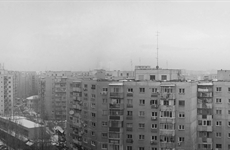
Housing Stories - webdocumentar
Status: (work in progress) Housing Stories is a documentary series on the diversity of living experiences in Bucharest and its outskirts. Structured inseven episodes focusing on different types of spaces - apartment buildings from the socialist era, new residential complexes, ghetto areas, student housing (“outdoor” living), former nationalized houses and those from the suburbs - the project aims to document the cultural diversity of living practices from the contemporary Romanian urban space. Each episode, monthly released on
Read more ...
-
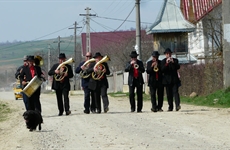
Concerts
Astra Film keeps the tradition in the 22nd edition of the festival, offering the public the chance to watch the best selection of documentary films. The novelty of this year is that, every evening, famous bands will complete the festive atmosphere from 5th to 11th of October. Highly praised musicians and instrumentalists have prepared performances for all music tastes, the cultural mosaic fitting perfectly with the diverse program of Astra Film Festival.
Read more ...
-

The Media Fund: development of documentary film projects
Valentina Miu, coordinator MEDIA Romania within the National Creative Europe Bureau (Unit for Project Management – Ministry of Culture), will present the European opportunities available to documentary filmmakers through the Creative Europe Programme (2014-2020) - EU MEDIA Sub-programme.Case study - Oana Giurgiu, director and producer (Libra Film), will be present at the seminar and she will share her experience of collaborating with MEDIA and present the way in which the development fund from Mediadesk was used for the documentary film project „Aliyah Dada”, which she directed and produced.The presentation will be held in the English language.
Read more ...